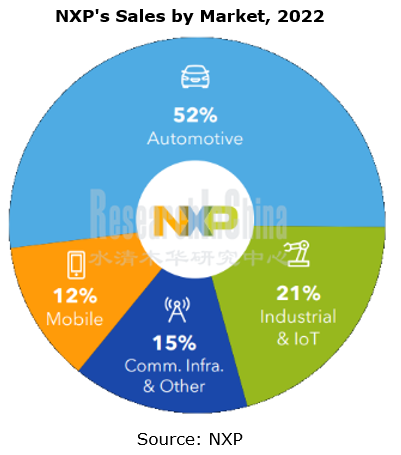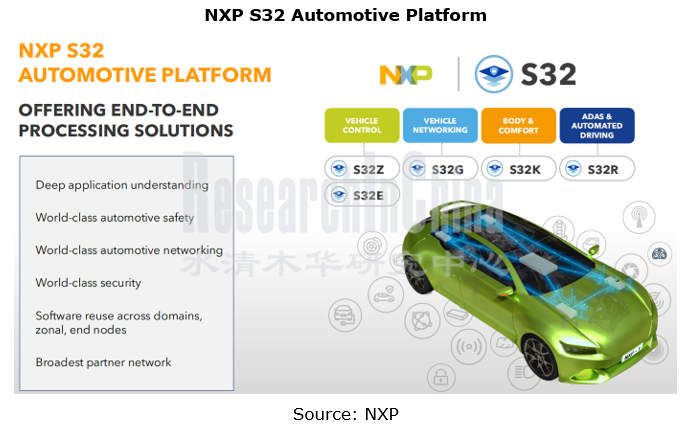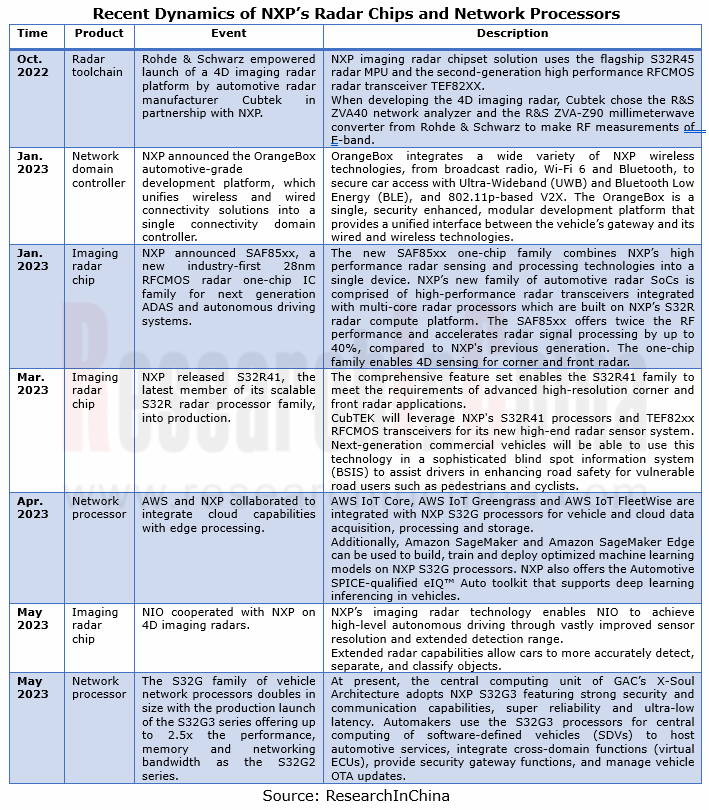In 2015, NXP acquired Freescale for USD11.8 billion, hereby becoming the largest automotive semiconductor vendor. Yet NXP's development progress has not always gone smoothly. In 2021, Infineon replaced NXP as the biggest automotive semiconductor vendor.
In 2022, NXP’s revenue jumped by 19.4% on the previous year to USD13.205 billion, 52% of which was from the Automotive; its net income hit USD2.833 billion, soaring by 48.6%. Despite a good growth, NXP was still positioned second in the industry.

NXP S32 Automotive Platform is designed for autonomous driving, involving the perception, decision and actuation. Among NXP's main ADAS chips, S32R is used for radars, S32A for L3~L5 CPUs, S32V for visual processing, S32G for automotive gateways, S32Z/S32E for real-time processing and power domain controller systems, and S32K for small domain controllers and small sub-nodes.

NXP once worked hard on S32V vision processor and BlueBox ADAS domain controller, but the result was not as expected. By contrast, it succeeded in S32R and S32G.
NXP has gambled on 4D imaging radar and network processor since 2022.
NXP has established a solid foothold in automotive radars for more than 20 years. By 2022, it had launched six generations of radar chips, and has transitioned to RFCMOS as early as the fourth generation. NXP has a leading position in the automotive radar market, offering radar technology to the top 20 automotive OEMs in the world.
In early 2022, NXP released the industry’s first dedicated 16nm imaging radar processor, the NXP S32R45, which is also the flagship of NXP’s 6th generation automotive radar chipset family. Additionally, the new NXP S32R41 was introduced to extend 4D imaging radar’s benefits to a much larger number of vehicles including high-end cars, vehicles used for mobility services, and mainstream passenger cars. Together these processors serve the L2+ through L5 autonomy sectors, enabling 4D imaging radar for 360-degree surround sensing.
Radar developers such as Hawkeye and Hasco have developed 4D imaging radars based on NXP S32R45.
Based on NXP S32R45, Hasco has developed 4-chip cascaded imaging radar, with a detection range of 350 meters, 1° horizontal resolution, 2° pitch resolution and ±75° FOV, covering more blind spots. Hasco has a high expectation of the prospect that 4D radar will completely replace conventional ordinary radars in the future. LRR30, Hasco’s 4D radar, can output 1,024 4D point clouds and track up to 64 objects. It is one of the first imaging radar sensors to be production-ready in the market. The LRR40 being developed by Hasco can output up to 3,072 4D point clouds and track 128 objects.

The layout in vehicle intelligence in recent year reveals that NXP focuses on deploying radar chips and network processors.

NXP's Thinking on Intelligent Transformation of the Automotive Industry
NXP believes that the automotive industry is building a new triangle value chain. OEMs are mainly responsible for architecture definition and system integration. To this end, they need basic technologies and chip platforms from semiconductor companies, as well as hardware and software integration and software actuation provided by Tier 1 suppliers. NXP aims to gradually step in the triangle value chain as a technical partner. That is to say, a technology company like NXP should have a team that serves Tier 1 suppliers, and another team targeting OEMs. Therefore, in recent years, NXP has been increasing the number of system engineers and software engineers to enhance its complete system-level solutions. In terms of products, NXP is transforming into a chip supplier, that is, it is integrating more software on the basis of chips. NXP’s software engineers have outnumbered hardware engineers. NXP continues system-level investments, in a bid to deeply understand how the automotive architecture develops and evolves.
Obviously, other automotive chip vendors such as Horizon Robotics are following suit, making the chip toolchain and grouped algorithms as perfect as possible to reduce the chip introduction workload for OEMs and Tier1 suppliers.
The automotive industry is heading towards software-defined vehicles, and it requires brand-new automotive software development methods to handle ECU integration, data-driven automotive services, secure cloud connection and service-oriented architectures. Automakers and Tier1 suppliers are confronted with new challenges in multi-tenancy (one MPU supports multiple virtual MCUs), network management, cloud services, functional safety and advanced safety technology. This makes it extremely difficult for automakers and Tier1 suppliers to introduce automotive intelligent chips.
NXP’s S32G Vehicle Integration Platform (GoldVIP) provides a reference vehicle integration platform that accelerates S32G hardware evaluation, software development and rapid prototyping efforts. NXP helps address these challenges with GoldVIP’s pre-integrated software, including from partners Airbiquity, Amazon Web Services, Argus Cyber Security and Elektrobit.
GoldVIP has integrated the following software:
Airbiquity OTAmatic client (for OTA updates)
AWS IoT Greengrass V2 edge runtime (for secure cloud services)
Elektrobit tresos AUTOSAR Classic Platform
Argus Cyber Security Intrusion Detection and Prevention System

Related Reports:
Ambarella’s Intelligent Driving Business Analysis Report, 2022-2023
NXP’s Intelligence Business Analysis Report, 2022-2023
Jingwei Hirain’s Automotive and Intelligent Driving Business Analysis Report, 2022-2023
Continental’s Intelligent Cockpit Business Analysis Report, 2022-2023
Bosch’s Intelligent Cockpit Business Analysis Report, 2022-2023
Baidu’s Intelligent Driving Business Analysis Report, 2022-2023
Aptiv’s Intelligent Driving Business Analysis Report, 2022-2023
ZF’s Intelligent Driving Business Analysis Report, 2022-2023
Continental’s Intelligent Driving Business Analysis Report, 2022-2023
Bosch’s Intelligent Driving Business Analysis Report, 2022-2023
Horizon Robotics’ Business and Products Analysis Report, 2022-2023
Desay SV’s Intelligent Driving Business Analysis Report, 2022-2023
Renesas Electronics’ Automotive Business Analysis Report, 2023
Infineon’s Intelligent Vehicle Business Analysis Report
Haomo.AI’s Intelligent Driving Business Analysis Report
SenseTime’s Intelligent Vehicle Business Analysis Report
Autonomous Driving Domain Controller and Central Computing Unit (CCU) Industry Report, 2025
Research on Autonomous Driving Domain Controllers: Monthly Penetration Rate Exceeded 30% for the First Time, and 700T+ Ultrahigh-compute Domain Controller Products Are Rapidly Installed in Vehicles
L...
China Automotive Lighting and Ambient Lighting System Research Report, 2025
Automotive Lighting System Research: In 2025H1, Autonomous Driving System (ADS) Marker Lamps Saw an 11-Fold Year-on-Year Growth and the Installation Rate of Automotive LED Lighting Approached 90...
Ecological Domain and Automotive Hardware Expansion Research Report, 2025
ResearchInChina has released the Ecological Domain and Automotive Hardware Expansion Research Report, 2025, which delves into the application of various automotive extended hardware, supplier ecologic...
Automotive Seating Innovation Technology Trend Research Report, 2025
Automotive Seating Research: With Popularization of Comfort Functions, How to Properly "Stack Functions" for Seating?
This report studies the status quo of seating technologies and functions in aspe...
Research Report on Chinese Suppliers’ Overseas Layout of Intelligent Driving, 2025
Research on Overseas Layout of Intelligent Driving: There Are Multiple Challenges in Overseas Layout, and Light-Asset Cooperation with Foreign Suppliers Emerges as the Optimal Solution at Present
20...
High-Voltage Power Supply in New Energy Vehicle (BMS, BDU, Relay, Integrated Battery Box) Research Report, 2025
The high-voltage power supply system is a core component of new energy vehicles. The battery pack serves as the central energy source, with the capacity of power battery affecting the vehicle's range,...
Automotive Radio Frequency System-on-Chip (RF SoC) and Module Research Report, 2025
Automotive RF SoC Research: The Pace of Introducing "Nerve Endings" such as UWB, NTN Satellite Communication, NearLink, and WIFI into Intelligent Vehicles Quickens
RF SoC (Radio Frequency Syst...
Automotive Power Management ICs and Signal Chain Chips Industry Research Report, 2025
Analog chips are used to process continuous analog signals from the natural world, such as light, sound, electricity/magnetism, position/speed/acceleration, and temperature. They are mainly composed o...
Global and China Electronic Rearview Mirror Industry Report, 2025
Based on the installation location, electronic rearview mirrors can be divided into electronic interior rearview mirrors (i.e., streaming media rearview mirrors) and electronic exterior rearview mirro...
Intelligent Cockpit Tier 1 Supplier Research Report, 2025 (Chinese Companies)
Intelligent Cockpit Tier1 Suppliers Research: Emerging AI Cockpit Products Fuel Layout of Full-Scenario Cockpit Ecosystem
This report mainly analyzes the current layout, innovative products, and deve...
Next-generation Central and Zonal Communication Network Topology and Chip Industry Research Report, 2025
The automotive E/E architecture is evolving towards a "central computing + zonal control" architecture, where the central computing platform is responsible for high-computing-power tasks, and zonal co...
Vehicle-road-cloud Integration and C-V2X Industry Research Report, 2025
Vehicle-side C-V2X Application Scenarios: Transition from R16 to R17, Providing a Communication Base for High-level Autonomous Driving, with the C-V2X On-board Explosion Period Approaching
In 2024, t...
Intelligent Cockpit Patent Analysis Report, 2025
Patent Trend: Three Major Directions of Intelligent Cockpits in 2025
This report explores the development trends of cutting-edge intelligent cockpits from the perspective of patents. The research sco...
Smart Car Information Security (Cybersecurity and Data Security) Research Report, 2025
Research on Automotive Information Security: AI Fusion Intelligent Protection and Ecological Collaboration Ensure Cybersecurity and Data Security
At present, what are the security risks faced by inte...
New Energy Vehicle 800-1000V High-Voltage Architecture and Supply Chain Research Report, 2025
Research on 800-1000V Architecture: to be installed in over 7 million vehicles in 2030, marking the arrival of the era of full-domain high voltage and megawatt supercharging.
In 2025, the 800-1000V h...
Foreign Tier 1 ADAS Suppliers Industry Research Report 2025
Research on Overseas Tier 1 ADAS Suppliers: Three Paths for Foreign Enterprises to Transfer to NOA
Foreign Tier 1 ADAS suppliers are obviously lagging behind in the field of NOA.
In 2024, Aptiv (2.6...
VLA Large Model Applications in Automotive and Robotics Research Report, 2025
ResearchInChina releases "VLA Large Model Applications in Automotive and Robotics Research Report, 2025": The report summarizes and analyzes the technical origin, development stages, application cases...
OEMs’ Next-generation In-vehicle Infotainment (IVI) System Trends Report, 2025
ResearchInChina releases the "OEMs’ Next-generation In-vehicle Infotainment (IVI) System Trends Report, 2025", which sorts out iterative development context of mainstream automakers in terms of infota...